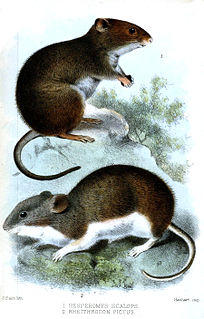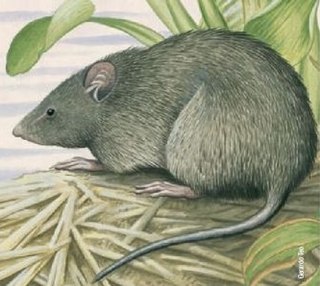Sooretamys angouya, also known as the rat-headed rice rat, and Paraguayan rice rat, is a rodent species from South America. It is found in northeastern Argentina, southern Brazil and Paraguay in forested areas within the Atlantic Forest and cerrado. Since 2006, it has been classified as the only species in the genus Sooretamys; previously, it was included in the genus Oryzomys. Its taxonomic history has been complex, with the names Oryzomys angouya, Oryzomys buccinatus, and Oryzomys ratticeps in use for various parts of the species at different times. Some variation in its karyotype has been reported, with 2n = 80 to 82 and FN = 88 to 90.
Brucepattersonius griserufescens, also known as the gray-bellied akodont or grey-bellied brucie, is a rodent in the cricetid genus Brucepattersonius from southeastern Brazil, specifically the states of Minas Gerais, Espírito Santo and Rio de Janeiro between 1,300 and 2,700 meters. It was one of four species of Brucepattersonius described by Hershkovitz in 1998; another, Brucepattersonius albinasus, also known as the white-nosed akodont or white-nosed brucie, was later argued to be the same as B. griserufescens, though further work is needed to confirm this. It is threatened by habitat loss but is also protected by Caparaó National Park.
The Bogotá grass mouse or Bogotá akodont, is a species of rodent in the family Cricetidae. It is found in the Andes eastern and central Colombia and northwestern Venezuela. Alavarado-Serrano and D'Elía (2013) have assigned the species to a new genus, Neomicroxus along with Neomicroxus latebricola.
Akodon boliviensis, also known as the Bolivian grass mouse or Bolivian akodont, is a species of rodent in the family Cricetidae. It is found in the Andes from southeastern Peru through Bolivia into northwestern Argentina.

Abrothrix longipilis, also known as the long-haired grass mouse or long-haired akodont, is a species of rodent in the family Cricetidae. It is found in central and southern Argentina and Chile. The southern Chilean Abrothrix sanborni may not be distinct from this species.
Abrothrix olivaceus markhami, also known as the Wellington Akodont or Markham's Grass Mouse, is a subspecies of the South American rodent Abrothrix olivaceus. It occurs on Wellington Island and the nearby Southern Patagonian Ice Field in southern Chile. It was previously recognized as a valid species, but is close to other recognized subspecies of A. olivaceus.
Abrothrix olivacea, also known as the olive grass mouse or olive akodont, is a species of rodent in the genus Abrothrix of family Cricetidae. It is found from northern Chile into southern Chile and Argentina, including the islands of Tierra del Fuego. It is prone to large swings in population size.

Abrothrix sanborni, also known as Sanborn's grass mouse or Sanborn's akodont, is a species of rodent in the genus Abrothrix of family Cricetidae. It is found in southern Argentina and Chile, but may not be distinct from A. longipilis.
Chelemys macronyx, also known as the Andean long-clawed mouse or Andean long-clawed akodont, is a species of rodent in the genus Chelemys of family Cricetidae. It is native to Argentina and Chile, where it is found in Patagonian Nothofagus forest and adjacent grasslands.

Chelemys is a genus of South American rodents in the tribe Abrotrichini of family Cricetidae. Three species—Chelemys delfini, Chelemys macronyx, and Chelemys megalonyx—are known, all found in central and southern Chile and Argentina.
Geoxus valdivianus, also known as the long-clawed mole mouse or Valdivian long-clawed akodont, is a species of rodent in the tribe Abrotrichini of family Cricetidae found in the Valdivian temperate rain forests and Magellanic subpolar forests of Argentina and Chile. It is one of two species in the genus Geoxus.

The fossorial giant rat is a species of rodent in the family Cricetidae. It is found in Argentina and Brazil but was determined extinct following a recent assessment of the conservation status of Sigmodontine rodents. Its natural habitat is assumed to be dry savanna, but there have been no ecological details reported.
Oligoryzomys magellanicus, also known as the Patagonian colilargo and the Magellanic pygmy rice rat, is a species of rodent in the genus Oligoryzomys of the family Cricetidae. It is found in the southernmost parts of Argentina and Chile, including Tierra del Fuego and other outlying islands. Its karyotype has 2n = 54 and FNa = 66.
Hylaeamys megacephalus, also known as Azara's broad-headed oryzomys or the large-headed rice rat, is a species of rodent in the genus Hylaeamys of family Cricetidae, of which it is the type species. It is found mainly in lowland tropical rainforest from its type locality in Paraguay north through central Brazil, French Guiana, Guyana, Suriname, and Venezuela onto Trinidad and Tobago. To its west and east, other closely related species of Hylaeamys are found: H. perenensis in western Amazonia, H. acritus in Bolivia, and H. laticeps and H. oniscus in the Atlantic Forest of eastern Brazil.
The spy hocicudo is a species of rodent in the family Cricetidae. It is found only in Paraguay.
Oxymycterus hucucha, also known as the Quechuan Hocicudo, is a species of rodent in the genus Oxymycterus of family Cricetidae from South America. It is found only in a small region of the Andes in central Bolivia, where it lives in cloud forest at altitudes from 2600 to 3000 m.
Geoxus annectens, also known as Pearson's long-clawed akodont or Pearson's long-clawed mouse, is a species of rodent in the tribe Abrotrichini of family Cricetidae. Molecular data suggests that its closest relative is Geoxus valdivianus. Formerly classified in its own genus, Pearsonomys, named after American zoologist Oliver Payne Pearson, it was moved to Geoxus in 2016 after a morphological and genetic reevaluation of the tribe Abrotrichini. This rodent is endemic to Chile, where it is found in Nothofagus forest of the Valdivian temperate rainforest ecoregion.
Brucepattersonius guarani, also known as the Guaraní akodont or Guaraní brucie, is a South American rodent in the genus Brucepattersonius. It is known from a single specimen from Misiones Province in northeastern Argentina, at the southern end of the Atlantic Forest. The species is protected by Moconá Provincial Park but is threatened by deforestation in nearby areas.
Chelemys delfini, also known as the Magellanic long-clawed akodont, is a species of rodent in the genus Chelemys of family Cricetidae. It is endemic to the areas of Punta Arenas and Torres del Paine National Park in southern Chile, where it lives in the grassland and scrub of the Magellanic steppe. It has sometimes been considered a subspecies of C. megalonyx.

Abrotrichini, also known as the Andean clade or southern Andean clade, is a tribe of rodents in the subfamily Sigmodontinae. It includes about fifteen species in four genera, distributed in South America from southern Peru to southernmost South America, including the Patagonian steppes. The earliest known fossils are from the Pliocene of Argentina.





